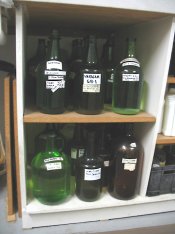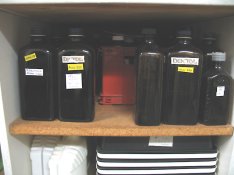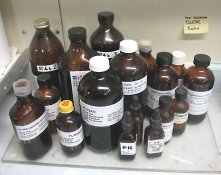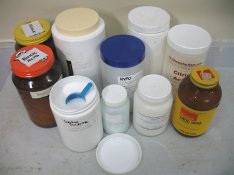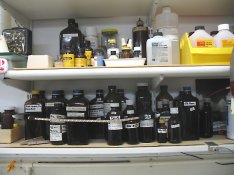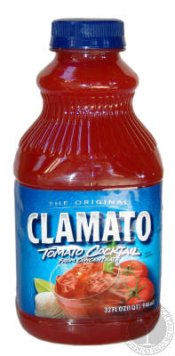Chris -
The issue of chemical storage is not all that complicated. First, you need to recognize that chemicals come in two forms - dry powders that must be mixed with water, and liquid concentrates. Dry powders are less expensive because you aren't paying for water, and because the weight is lower, shipping costs are less. And dry powders typically aren't considered hazardous and don't require special shipping. Liquid concentrates are far more convenient to use, and if you don't live near a large store that stocks a large selection of chemicals, may be the only thing that your local dealer will carry.
Dry chemicals come in two forms - prepackaged mixes, and raw chemicals (from specialty dealers such as Photographer's Formulary, Artcraft Chemicals, or Bostick & Sullivan). If you are using raw chemicals, you can mix whatever quantity you want - simply use a scale to weigh out the individual components. But if you are using the prepackaged mixes from Kodak, Ilford or some other supplier, you must mix the entire batch, and the final quantity of liquid that you have to store will be defined by the size of the package you buy. Manufacturers typically provide batch kits in one quart (or one liter) and one gallon (four liter) sizes. Buying the larger size is less expensive, but then creates the issue of storage.
The other distinction you need to have is that there is usually a 'stock' solution and a 'working' solution. The stock solution is intended for storage, and is diluted with water to make a 'working' solution. Working solutions typically are intended for one-time use and disposal. There are schemes for reusing working solutions and some manufacturers sell replenishment kits. But these are intended for large quantity uses for whom chemical costs are a significant component of their total operating costs. Most home users are better off using working solutions as 'one-shot' and disposing of the chemicals after they are used.
So if you are starting with dry mixes, then you have a choice between one quart and one gallon sizes. You can get gallon containers, and that may make sense for chemicals that tend to have a long shelf life - fixer or hypo clear, as examples. But developers don't age very well, and to get the longest life from the stock solution, you need to minimize exposure to air. So for developers, if you choose the one gallon package size, it's best to store the stock solution in four one-quart containers. Fill three all the way to the top, and seal them tightly. Then, the fourth container will only be partially full, and is the first container to be used.
If your starting point is liquid concentrates, consider these to be stock solutions that are diluted as required for one-time use. They are available in one quart, two quart and one gallon sizes although most smaller dealers typically only stock the quart sizes.
Now the matter of containers. You can certainly purchase storage containers, but the fact is that you don't need fancy bottles to store chemicals. Any clean container will work. Stop, fixer, and hypoclear can be stored in plastic containers. You can recycle the containers that liquid concentrates are supplied in, or you can recycle containers from ordinary household items. I use shampoo bottles, bleach jugs, lemon juice concentrate bottles, beer bottles, and wine bottles. Practically, you want something with a good screw closure, and if you standardize on the ubiquitous 28mm closure, you will find that you have a never-ending supply of replacements. Try to avoid bottles with exotic closures. And of course, bottles must be scrupulously clean before use - rinse them out several times with warm water, then fill them with water and let them sit for a few days, then rinse again.
Developers that you mix from powders should be stored in glass because air incursion can cause accelerated aging of developers. You don't need brown glass - any color works just find.
Finally, a critical point is to make sure that your chemicals are stored safely. The chemicals used in typical home darkrooms are not all that dangerous, but they don't go very well with a ham sandwich. Make sure that chemicals and food can never be confused, and make sure that children can't get to them. If you don't have a fixed darkroom space where you can store your chemicals, investing in an inexpensive cabinet to store them in may make sense.
Wry chemicals, you must mix the complete package of
 or here in Holland.
or here in Holland. 
 or here in Holland.
or here in Holland. 









 I don't fill the smallest one to brim from larger, actually.... I don't touch the larger bottles until I need to open it to make use of it.
I don't fill the smallest one to brim from larger, actually.... I don't touch the larger bottles until I need to open it to make use of it.